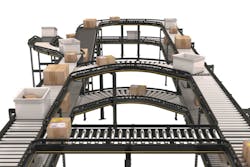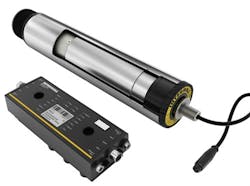Conveyor selection — six parameters to consider for optimal performance
A recent report projects that the global conveyor systems market will grow to $7.6 billion by 2022. This demand will be driven by more advanced conveying systems that can improve production efficiency, cut costs, and be customized to meet a range of industry requirements.1 These systems must also be able to integrate with the latest intelligent software solutions to enable Industrial Internet of Things (IIoT) capabilities for further efficiencies. As the momentum behind industrial conveyor systems continues to mount, conveyor selection will become more important for end-users operating distributions center, processing facilities, and warehouses.
Six performance considerations for effective conveyor selection
There are five fundamental specifications for conveyor systems:
- Maximum throughput per time unit
- Geometry of the material to be transported
- Weight and material of the transported product
- Control requirements
- Environmental conditions
Once these guidelines are established, operators should base their conveyor selection strategy on six key performance consideration to ensure optimum performance of their conveyor system.
Image 2. This roller drive is a 24-volt, direct-current, brushless motor integrated within a conveyor roller. It operates in conjunction with the Ethernet/ IP ZPA, four-zone multicontrol card that controls and integrates the roller into many conveyor system applications.
Conveyor selection factor no. 1: Zero pressure
Conventional conveyor systems, which have permanent active drives, generate accumulation pressure. This pressure can cause products to collide in transit, potentially damaging the products. To avoid this setback, system integrators have actively begun designing zero-pressure conveyor systems to replace old systems that use electropneumatic controls that have individual accumulation sections.
Because the sections control the movement on a case-by-case basis, operators who have zero-pressure conveyor systems have considerably lowered waste costs from goods damaged by impact loading or accumulated pressure. With the high number of orders and returns, distribution centers simply cannot afford risking products mishandled in transit and must minimize the costs associated with handling waste. The system can also be used in buffer segments to guarantee an optimum filling ratio of the transport zone or to separate transport materials. Additionally, a demand-driven conveyor system significantly lowers noise levels, which provides a better working environment for operators and other personnel.
Conveyor selection factor no. 2: Decentralized solutions
Conventional conveyor sections are powered by gear motors with 400 to 480 volts. These motors drive long flat belts that usually operate 24 hours per day, regardless of how many goods are being transported. A respective conveyor zone is switched on and off using pneumatic or electric control units. Unlike traditional conveyor systems in which central drive motors provide the power for the entire line, solutions that are decentralized can be adapted to an individual shipment’s requirements.
Having decentralized drives in each individual conveyor zone ensures that a conveyor will only move if goods are present. The ability to switch zones on and off independent of each other enables more efficient system use and prevents the wear caused by unnecessary machinery operation, which can increase the system’s life cycle. Decentralized drives can also increase energy savings – facilities that have installed this technology have reported reduced power consumption of up to 50 percent.
Conveyor selection factor no. 3: Flexibility
Often, traditional conveyor systems are perceived as inflexible and unable to meet changing market conditions. A survey of retailers, manufacturers, wholesalers and third-party logistics firms conducted by Tompkins Supply Chain Consortium found that companies had, on average, nearly three distribution operations with systems that were more than 15 years old.2 Ultimately, end users must quickly react to short-term changes in the order structures and the range of products.
Leveraging conveyors that employ certified network interface cards can allow the user to configure sensor and drive properties, such as speed, direction of rotation, acceleration and braking ramps, using either a web user interface or the programmable logic controller’s programming software.
Continuous mass processing of identical goods is no longer the industry standard; it has been replaced by shorter order cycles with varying packaging size and weight changes. In fact, 76 percent of Interroll customers stated that the typical throughput of material handling systems will continue to increase. The solution must also be incorporated easily into tomorrow’s changing IT environments or Industry 4.0.
Just as important as the solution’s range of applications is the modularity of the platform, which, much like LEGO blocks, can be flexibly configured and expanded using standard components (see Image 1). This makes installation and maintenance easier, provides shorter delivery times and gives system integrators key benefits as early as the planning phase. As a result, modular conveyor systems with largely standardized components and sections that can be moved, reconfigured, updated and combined interchangeably are becomingly increasingly appealing.
Conveyor selection factor no. 4: Scalability
When order structures, throughput requirements or product mix suddenly shifts, the modular design of an entire conveyor system must be reevaluated. Conveyor rollers that are easily removable, combined with conveyor modules that offer versatility, enable seamless system extensions and reconfigurations without significant structural changes. This ensures scalability for future growth and that the investment is truly future-proof.
Conveyor selection factor no. 5: Smart solutions
An Industry 4.0 study conducted by global management consulting firm McKinsey & Company, reported only 30 percent of technology suppliers and 16 percent of manufacturers have an overall Industry 4.0 strategy in place, and just 24 percent have assigned clear responsibilities to implement it.3 As IIoT increasingly becomes a daily reality, the complexity of logistics will expand.
Based on the internet, mobile communications and microcomputers, embedded cyber-physical systems are created and grow more intelligent every day. They will be at the heart of the smart factory in which machines, warehousing systems and operating functions are interconnected and exchange information locally and globally. Choosing a conveyor system outfitted with the latest and most advanced technology will help make the transition to smart factories easier for companies. Leveraging conveyors that employ certified network interface cards can allow the user to configure sensor and drive properties, such as speed, direction of rotation, acceleration and braking ramps, using either a web user interface or the programmable logic controller’s programming software.
Conveyor selection factor no. 6: Adaptable accessories
Selecting the proper accessories is key to maximizing conveyor system functionality. A multitude of options (motors, rollers, controls, belts and chains) are available to enhance conveyors, allowing operators to select components that enable goods to be conveyed in every direction and provide better acceleration and deceleration.
For example, gravity roller conveyors are often responsible for handling the final stage of goods moving through sorting systems.
Many gravity conveyors are sold without devices that regulate speed, which can lead to damaged goods. By installing a speed controller, operators have precise control over the speed at which packages of differing weights travel.
Parting thoughts on conveyor systems
As the manufacturing and processing sectors continue their upward trajectories, more warehouses and other facilities are embracing automation to optimize production processes and meet demands. Globalization of the world economy, shorter innovation cycles and a high level of market transparency have turned logistics into a pivotal factor for success. To maximize the benefits of automation, facility operators must employ a conveyor selection strategy that lowers costs by offering a smart, energy-efficient solution that requires minimal maintenance. The most effective conveyor system will serve as a supporting player in a facility’s production, helping it prepare for the next wave of innovation in intralogistics.
Stephen Cwiak, senior vice president – head of Subsystems at Interroll Group, has developed sophisticated conveyor and sortation systems for leading companies throughout his career. Each system builds on previous experience while introducing the latest technology. As we move into a heightened era of technology-savvy material handling systems, Cwiak continues to find solid solutions that push the boundaries of today’s intralogistics. He may be reached at [email protected].
References
- “Conveyor Systems Market Overview.” Allied Market Research, http://alliedmarketresearch.com
- “Aging Material Handling Equipment Puts Your Distribution/Fulfillment Center at Risk,” Tompkins International, http://tompkinsinc.com
- “Getting the most out of Industry 4.0.,” McKinsey & Company, http://mckinsey.com


